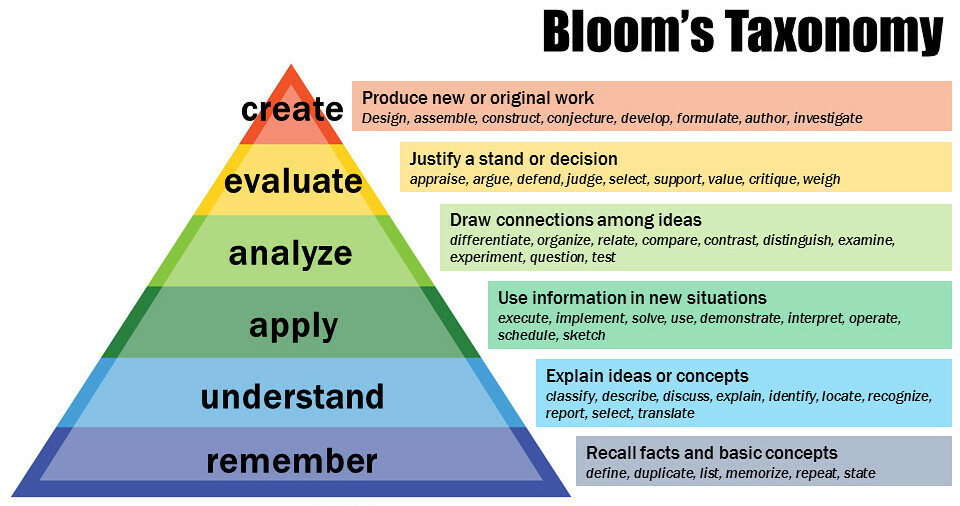Writing Learning Objectives
What are Learning Objectives?
Course Level Student Learning Objectives (SLOs) are statements in specific and measurable terms that describe what the learner will know or be able to do as a result of engaging in a learning activity.
Course objectives state what students will be able to do by the end of the course, unit or other defined period of time.
More specific objectives can be written for subsets of the course like units of instruction or chapters of a book.
Program objectives and University Wide Student Learning Objectives state more broad, higher-level objectives that cover longer periods of time. For example, a program objective may not be able to be achieved by a student until their third year or perhaps by the time they graduate.
Why Do I Need Them?
Objectives need to be written in a way that states how you will know when a student has mastered the knowledge or skill. Well written objectives help define activities, assignments, and assessments created for the course. Objectives are milestones along the way to help ensure students reach their goals.
How do I Create Them?
In 1956 Benjamin Bloom created a learning framework consisting of 6 major categories: Knowledge, Comprehension, Application, Analysis, Synthesis and Evaluation.
Bloom’s Taxonomy (Revised)
In 2001, David Krathwohl revised the taxonomy to include the following domains:
- Remember: Recall facts and basic concepts
- Understand: Explain ideas or concepts
- Apply: Use information in new situations
- Analyze: Make connections among ideas
- Evaluate: Justify a stand or decision
- Create: Produce new or original work
Krathwohl went on to separate out knowledge into four dimensions, flowing throughout the six domains listed above:
- Factual Knowledge: The basic elements that students must know to be acquainted with a discipline or solve problems in it.
- Conceptual Knowledge: The interrelationships among the basic elements within a larger structure that enable them to function together.
- Procedural Knowledge: How to do something; methods of inquiry, and criteria for using skills, algorithms, techniques, and methods.
- Metacognitive Knowledge: Knowledge of cognition in general as well as awareness and knowledge of one’s own cognition.
In revising the taxonomy to include cognition, Krathwohl infused knowledge throughout the levels of the traditional pyramid, creating a taxonomy table to help better align the individual domains with the knowledge dimension.

| Sample Action Verbs | Remember | Understand | Apply | Analyze | Evaluate | Create |
|---|---|---|---|---|---|---|
| Define | Classify | Execute | Differentiate | Appraise | Design | |
| Duplicate | Describe | Implement | Organize | Argue | Assemble | |
| List | Discuss | Solve | Relate | Defend | Construct | |
| Memorize | Explain | Use | Compare | Judge | Conjecture | |
| Verbs | Repeat | Identify | Demonstrate | Contrast | Select | Develop |
| State | Locate | Interpret | Distinguish | Support | Formulate | |
| Recognize | Operate | Examine | Value | Author | ||
| Report | Schedule | Experiment | Critique | Investigate | ||
| Select | Sketch | Question | Weigh | |||
| Translate | Test |
| The Knowledge Dimension | Remember | Understand | Apply | Analyze | Evaluate | Create |
|---|---|---|---|---|---|---|
| Factual Knowledge | ||||||
| Conceptual Knowledge | ||||||
| Procedural Knowledge | ||||||
| Metacognitive Knowledge |
Objectives can be written for all three learning domains (cognitive, psychomotor and affective).
Objectives need four parts: (ABCD)
- Audience – Who should be performing the action?
- Behavior – What observable and measurable behavior are you looking for?
- Condition – Under what conditions will they perform this action?
- Degree – What is the standard of acceptable performance? (E.g. How well? How much? How fast?)
Sample Objectives
- Given an irregular verb, the student will be able to conjugate the verb in the present and past tense.
- Given the variables and a formula, the student will be able to correctly solve for the unknown number.
- Given a piece of sheet music, the student will be able to label the parts of the piece.
- Given a patient’s history and diagnosis, the student will be able to construct a physical therapy treatment plan.
Adapted from the following sources:
Morrison, Ross, Kalman and Kemp (2019). Designing Effective Instruction. Danvers, MA; Wiley.
Anderson, L. W.,& Krathwohl, D. R. (2001). A taxonomy for learning, teaching, and assessing, Abridged Edition. Boston, MA: Allyn and Bacon.
